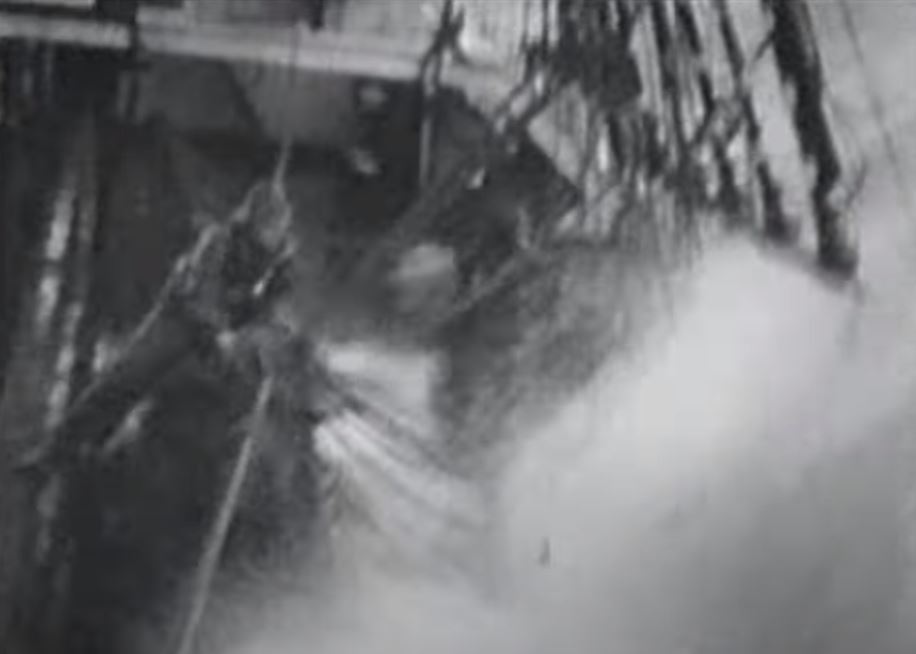Sailing Ships and Windjammers - with links to videos
Click the red links to YouTube videos. Nb and some links may expire.
Great Ships The Windjammers

Taken from YouTube Great Ships The Windjammers
Windjammers were the last breed of large commercial sailing vessel, designed well after the Industrial Revolution using scientific methods and modern materials such as iron and steel in their construction. In general, the ships displaced between 2,000 and 5,000 tons and were cheaper than their wooden hulled counterparts for three main reasons: (1) iron was stronger and enabled larger ship size, capable of delivering considerable economies of scale, (2) iron hulls took up less space, allowing more room for cargo in a given hull size, and (3) iron required less maintenance than a wooden hull.
The 5-masted Preußen was the largest windjammer ever built, measuring 5,081 GRT.
The four-masted iron-hulled ship, introduced in 1875 by the full-rigged County of Peebles, represented an especially efficient configuration that prolonged the competitiveness of sail against steam in the later part of the 19th century. The four-masted barque was the ultimate refinement of aerodynamic study and thousands of years of seafaring experience. The barque rig can outperform the schooner rig, sail upwind better than full-riggers, and is easier to handle than full square rig.
The largest windjammer ever built was the five-masted full-rigged ship Preußen, which had a load capacity of 7,800 tons. She was also one of the fastest, regularly logging 16 knots (30 km/h) average speed on transatlantic voyages. Unfortunately speed was her undoing, as she collided with a steamer that underestimated the speed of the Preußen when crossing before her. The second largest windjammer was France II.
The large sail plans and raked bows of windjammers cause them to be confused with clippers, but there are significant differences between them. Clippers were optimized for speed, windjammers for cargo capacity and ease of handling. Most clippers were of composite construction, full rigged and had a cargo capacity of less than 1,000 tonnes; windjammers were iron and steel hulled, usually barque rigged, and had far greater cargo capacities. Clippers had already begun to disappear when windjammers emerged.
The largest windjammer to survive, the four-masted barque Moshulu, the ship on which Eric Newby, author of Last Grain Race sailed, today a restaurant ship at Philadelphia, Pennsylvania, United StatesWindjammers were mainly built from the 1870s to 1900, when steamships began to outpace them economically, due to their ability to keep a schedule regardless of the wind. Steel hulls also replaced iron hulls at around the same time. Sailing ships could hold their own on ultra-long voyages such as Australia to Europe. Since they were faster than steamers, did not require bunkerage for coal nor freshwater for steam, they were able to compete with steam ships, which usually could barely do 8 kn. Many of the famous windjammers sailed under the Finnish flag during at least some part of their careers. Ship-owner Gustaf Erikson of Mariehamn, Åland Islands, Finland, was famous for his windjammer fleet during the inter-war years. Other renowned sailing ship companies running their affairs despite the encroachment of the machine age were F. Laeisz of Hamburg and A.D. Bordes of Dunkirk.[3]
Typically, windjammers are equipped with semi-mechanized rigging, steel profile masts and yards and steel cables as running rigging where possible. Often also the running rigging was handled by motor driven winches powered by donkey enginess. The combination of a large, efficient sail plan and hull optimized for good hydrodynamics allowed windjammers to sustain high cruising speeds; most four-masted barques were able to cruise at 15 knots (28 km/h) on plausible winds, some logged 18 knots (33 km/h) regularly and Herzogin Cecilie is known to have logged 21 knots (39 km/h).
The Last Cape Horners
YouTube link to The Last Cape Horners


Four Masted Barque rounding Cape Horn 1928
YouTube link to Four Masted Barque rounding Cape Horn 1928

US Brig Niagara Under Full Sail
YouTube link to US Brig Niagara Under Full Sail
Around the world in a square rigged ship
YouTube link to Around the world in a square rigged ship
The Boats That Built Britain - The Phoenix - Part 1 (Tom Cunliffe)
YouTube link to The Boats That Built Britain – The Phoenix – Part 1 (Tom Cunliffe)
The Cutty Sark: Inside The Fastest Ship Of The Victorian Era
YouTube link to The Cutty Sark: Inside The Fastest Ship Of The Victorian Era
Furling sails aboard the square rigger Joseph Conrad
YouTube link to Furling sails aboard the square rigger Joseph Conrad
Sailing Ireland on a Tall Ship (4K)
YouTube link to Sailing Ireland on a Tall Ship (4K)
Windjammers: The Last Grain Races (silent mono)
YouTube link to Windjammers: The Last Grain Races (silent mono)
Lynx - America's Privateer Trailer HD
YouTube link to Lynx – America’s Privateer Trailer HD
Square rig tall ship James Craig -2000 to 2010
YouTube link to Square rig tall ship James Craig -2000 to 2010
The Scariest Ship to Ever Sail the Seven Seas
YouTube link to The Scariest Ship to Ever Sail the Seven Seas
Bark Europa, Force 8, 10 and 11 June 2010
YouTube link to Bark Europa, Force 8, 10 and 11 June 2010
Dutch schooner OOSTERSCHELDE, sailing from New Zealand to Cape Horn in 1997
YouTube link to Dutch schooner OOSTERSCHELDE, sailing from New Zealand to Cape Horn in 1997
1936 U.S. Navy Training on a Square Rigger (Silent)
YouTube link to 1936 U.S. Navy Training on a Square Rigger (Silent)
Admiral - Ship of the Line Battle – Retreat
YouTube link to Admiral – Ship of the Line Battle – Retreat
Admiral – 2015. When the young republic of The Netherlands is attacked and the country itself is on the brink of civil war, only Michiel de Ruyter can lead the county’s strongest weapon, the Dutch fleet.
















